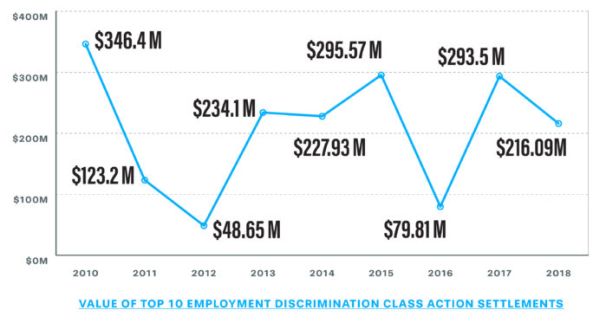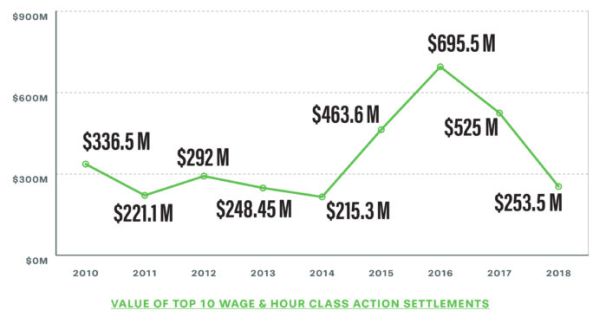Seyfarth Synopsis: As measured by the top ten largest case resolutions in various workplace class action categories, overall settlement numbers decreased significantly in 2018 as compared to 2017. After settlement numbers were at an all-time high in 2017, those numbers fell dramatically over the past year. In sum, the ability of the plaintiffs' bar to monetize their class action filings hit a significant wall.
This trend harkened back to the U.S. Supreme Court's decision in Wal-Mart, Inc. v. Dukes in 2011. By tightening Rule 23 standards and raising the bar for class certification, Wal-Mart made it more difficult for plaintiffs to certify class actions, and to convert their class action filings into substantial settlements. These barriers became more formidable in 2018 with the Supreme Court's ruling in Epic Systems v. Lewis, which upheld the validity of class action waivers in mandatory workplace arbitration agreements.
The "Wal-Mart/Epic Systems" phenomenon is still being played out, as well as manifesting itself in settlement dynamics. It is expected that the force of this barrier will be felt more profoundly in 2019.
Considering all types of workplace class actions, settlement numbers in 2018 totaled $1.32 billion, which decreased significantly from 2017 when such settlements totaled $2.72 billion and in 2016 when such settlements totaled $1.75 billion.
The following graphic shows this trend:

In terms of the story behind the numbers, the breakouts by types of workplace class action settlements are instructive.
In 2018, there was a significant downward trend for the value of settlement of ERISA and wage & hour class action settlements, as well as for government enforcement lawsuits. In addition, there were significant decreases across-the-board for resolutions of class actions involving employment discrimination claims and statutory workplace laws. By any measure, class action recoveries were down.
This phenomenon is shown by the following chart for 2018 settlement numbers:

By type of case, settlements values in ERISA class actions, wage & hour class actions, and government enforcement cases experienced the most significant decreases.
The top ten settlements in the private plaintiff statutory class action category (e.g., cases brought for breach of contract for employee benefits, and workplace anti-trust laws and statutes such as the Fair Credit Reporting Act or the Worker Adjustment and Retraining Notification Act) totaled $411.15 million, which represented a slight decrease from $487.28 million in 2017 (but an increase from $114.7 million in 2016.)
The following chart tracks these figures:

The pattern for employment discrimination class action settlements likewise followed a slight downward trend in 2018. The top ten settlements totaled $216.09 million as compared to $293.5 million in 2017. The comparison of the settlement figures with previous settlement activity over the last decade is illustrated in the following chart:

In 2018, the value of the top ten largest employment discrimination class action settlements of $216.09 million was the fourth lowest figure since 2010, and largely aligned with the trend that started in 2011 (after Wal-Mart was decided) that showed decreases in settlement amounts over three years of that four-year period.
This trend also held for wage & hour class action settlements. In 2018, the value of the top ten wage & hour settlements was $253.18 million. This was a significant decrease from 2017, when the value of the top ten settlements spiked at $574.49 million, which was the second highest annual total in wage & hour class actions ever. When coupled together, the two-year period of 2016 and 2017 saw over $1.2 billion in the top wage & hour settlements. Further, this is most telling in examining the last four years, for 2016 represented almost a quadrupling (after two years of declining numbers in 2013 and 2014) in the value of the top wage & hour settlements as compared to 2014. Given the ruling in Epic Systems this past year, settlement numbers are apt to remain on a downward trajectory in 2019.
This trend is illustrated by the following chart:

Relatedly, the top ten settlements in government enforcement litigation experienced a downward arc, as they decreased nearly four-fold to $126.7 million. This compared to the figure of $485.2 million in 2017. That being said, these numbers were slightly above the three year trend from 2014 to 2016 when governmental enforcement litigation settlements trended under $100 million for three years running. This trend is illustrated by the following chart of settlements from 2010 to 2018:
image
ERISA class action settlements fell precipitously in 2018. The top ten settlements fell nearly three-fold to $313.4 million, which were down from $927 million in 2017 and $807.4 million in 2016. Further, given that ERISA class action settlements for the two-year period of 2016 and 2018 were a combined $1.73 billion, the figure for 2018 represents a clear reversal for the plaintiffs' bar. This trend is illustrated by the following chart of settlements from 2010 to 2018:
image
Implications For Employers:
Settlement trends in workplace class action litigation are impacted by many factors. In the coming year, settlement activity is apt to be influenced by developing case law interpreting U.S. Supreme Court rulings such as Epic Systems, the Trump Administration's labor and employment enforcement policies, case filing trends of the plaintiffs' class action bar, and class certification rulings.
The content of this article is intended to provide a general guide to the subject matter. Specialist advice should be sought about your specific circumstances.

